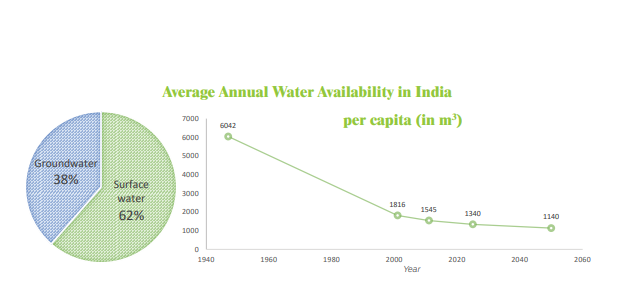Groundwater is a renewable water source, but not 100 per cent like renewable energy sources. It can be replenished, but at the rate India is extracting its groundwater annually—more than China and the USA combined—there is a threat that many regions could run out of groundwater.
Groundwater is not unlimited. We have been extracting groundwater for centuries, but it seems there is still plenty. Why? Because it is replenished naturally by rain, snowmelt, and artificially by digging up deep wells. The concept of groundwater is as simple as transactions in our bank accounts. Consider the groundwater beneath your feet as your deposit in a bank. Just as we diligently deposit our earnings into a bank for future use, nature keeps accumulating water in aquifers during times of plenty, perhaps preparing for times of scarcity.

Now, consider spending money on extracting groundwater. Each withdrawal mirrors the extraction of water from underground aquifers to meet our immediate needs. However, just as excessive spending can deplete our savings, indiscriminate groundwater extraction can lead to the depletion of aquifers, threatening the sustainability of our water supply. It simply means we should use water judiciously, and if it is more than we deposit or recharge, the region can face water scarcity in the future.
But there’s hope. Much like we can replenish our bank accounts through regular savings, we can recharge groundwater reserves through conscious conservation efforts. Just as rainwater refills reservoirs, recharging groundwater involves replenishing aquifers through sustainable practices like efficient rainwater harvesting, reducing water waste, and preventing encroachment on wetlands and natural waterways.
Groundwater Usage
India extracted about 245 billion cubic metres of groundwater in 2020, accounting for about 25 per cent of the global extraction of groundwater. A 2022 report says the total extraction of China and the United States of America combined is lower.
Eighty-seven per cent of this groundwater is used for irrigation, and the remaining is used for domestic (9%) and industrial (3%) purposes. About 60 per cent of India’s agriculture is dependent on groundwater, while globally, the number is 38 per cent. It clearly shows that the government needs to think of innovative ways to reduce water usage in agriculture and also optimise the increasing use of groundwater for domestic and industrial purposes.
The use of groundwater has made agriculture less dependent on the monsoon. In a country where over 600 million people depend on agriculture, it becomes more important to sustain groundwater in cases of monsoon variability. A report highlights that a rainfall deficit in 1963–66 decreased India’s food production by 20 per cent, but a similar drought in 1987–88 had a very small impact on food production, largely due to the widespread use of groundwater by that time.
Data shows that the amount of water used in agriculture has decreased from 92 per cent in 2004 to 87 per cent in 2022. But there is no significant decline in the overall extraction of groundwater. It is important to highlight that the overall average annual availability of water has declined from 6042 BCM in 1947 to 1123 BCM in 2022. India should work on sustaining this precious resource and ensuring that water remains adequately available for future generations.
Sustaining Groundwater
Groundwater is a major source of water for irrigation in India. The depletion of groundwater could pose severe economic and environmental threats, including slow economic growth, food security issues, water supply challenges in cities, and land subsidence, especially in coastal areas.
It is true that surface water accounts for about 62 per cent of the average annual utilisable water availability, and groundwater accounts for 38 per cent. Urban residents are increasingly relying on groundwater due to unreliable and inadequate municipal water supplies. It is essential that local governments and water management agencies focus on improving water management, not just fulfilling the growing demands but also making the water supply sustainable.
As per the rule, most residential complexes are bound to have rainwater harvesting systems inside, but there should be annual monitoring to ascertain their efficacy. In a recent verdict, the National Green Tribunal had focused on monitoring by development agencies. As per a news report in The Indian Express, in adherence to existing norms, all structures spanning an area larger than 100 square metres in Delhi must incorporate rainwater harvesting systems. Failure to comply can result in a penalty of an additional 50% of the monthly Delhi Jal Board bill.
For rural areas, the Government of India launched the Atal Bhujal Yojna in 2019 to improve groundwater management through community participation. The scheme was launched for seven states—Gujarat, Haryana, Karnataka, Madhya Pradesh, Maharashtra, Rajasthan, and Uttar Pradesh. The major objective of the scheme is to improve the management of groundwater resources in select water-stressed areas in identified states. The five-year implementation of the programme—with a total allocation of Rs 6,000 crore—started in 20–2021. The government-appointed agencies are providing training to farmers on how to use new techniques to save water and how to improve the water table in water-stressed regions. Considering the highest use of groundwater in agriculture, the scheme seems like a good start. By becoming aware today, we can avert the dangers of tomorrow.
What is Groundwater?
Groundwater is the water that seeps through rocks and soil and is stored below the ground. The groundwater is stored in aquifers. The area where water fills the aquifer is called the saturated zone. The depth at which groundwater is found is called the water table. It can be as shallow as a foot below the ground, or it can be a few hundred metres deep. Heavy rains can cause the water table to rise, and continuous extraction can cause the water level to fall.
